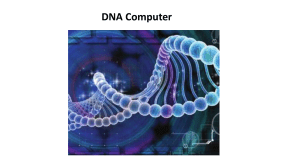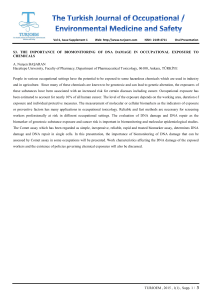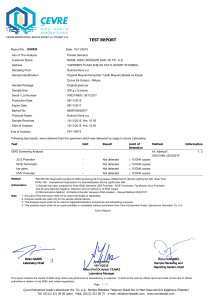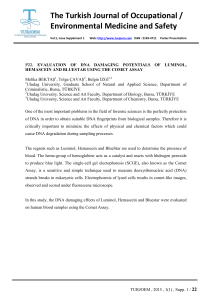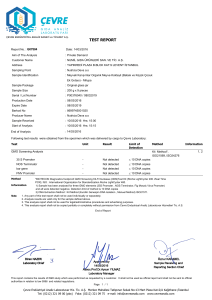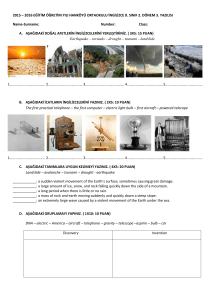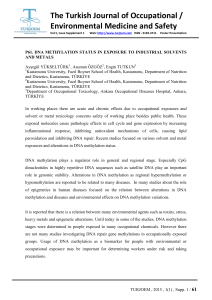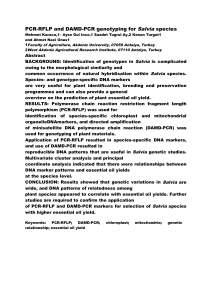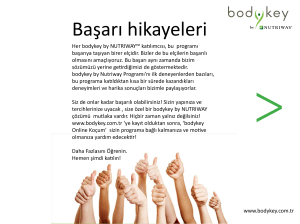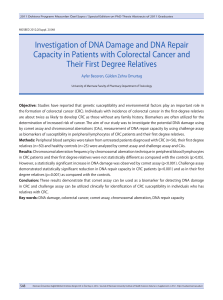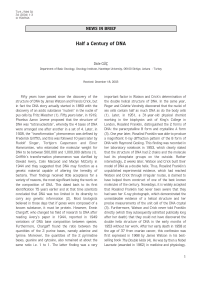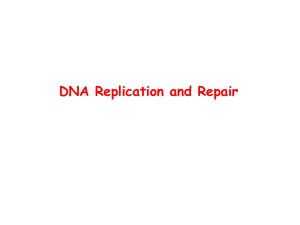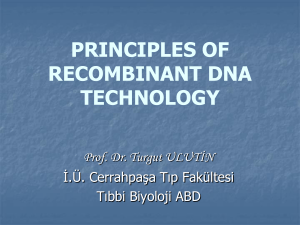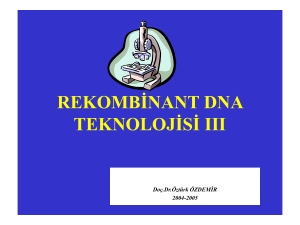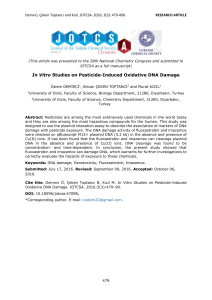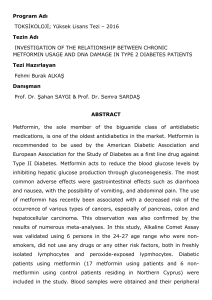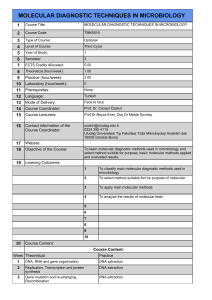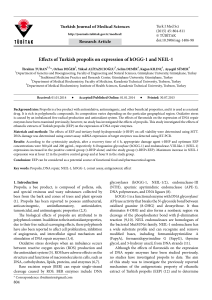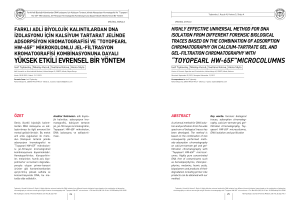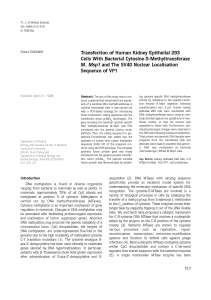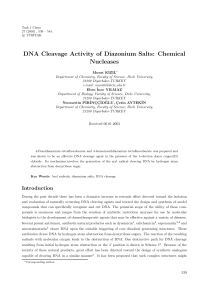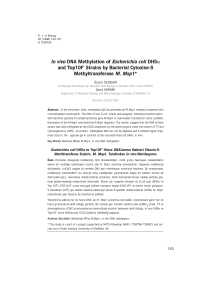dna-kramati̇n ve kromozom
advertisement
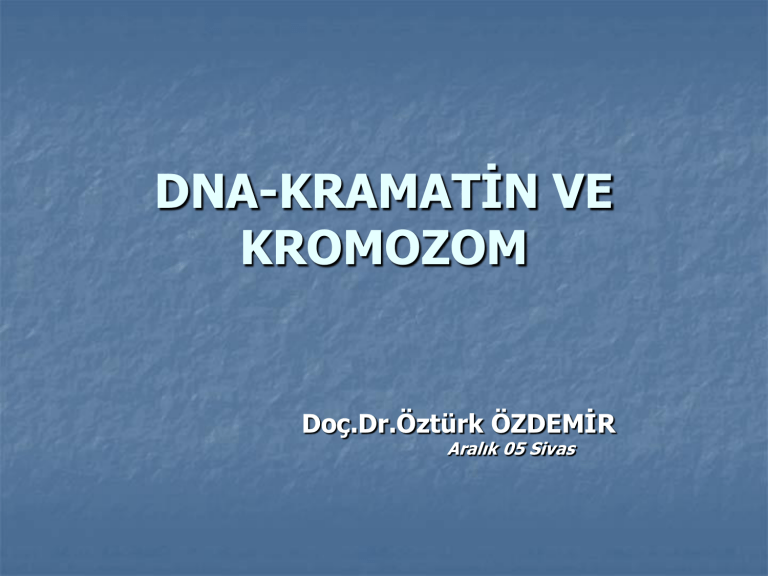
DNA-KRAMATİN VE KROMOZOM Doç.Dr.Öztürk ÖZDEMİR Aralık 05 Sivas What is a chromosome? Made up of CHROMATIN:1/3 DNA 1/3 HISTONE PROTEINS 1/3 OTHER PROTEINS Proliferation signals ATP-Dependent Chromatin Remodeling Complexes Chromatin Structure and Gene Expression by Elgin and Workman, Oxford University Press. Horn and Peterson. Science 297:1824, 2002 KROMOZOM Genomik DNA’nın türe özgü sayı ve morfolojide paketlenme şekline denir. - Ökaryotik hücrelere özgüdür - Kompleks DNA’nın bölünme esnasında yavru hücrelere eşit ve mutasyonsuz pay edilmesi esasına dayanır. - En ideal formasyon hücrenin metafaz evresinde olur - DNA-gen paketlenmesi dışında “gen aktivitesi” bakımından negatif aksiyona sahip. Bu formda DNA replike -transkribe olamaz ve gen ekspressiyonu yoktur. KROMOZOM -DNA PAKETLENMESİ Kademe 1- Primer Birim Adı DNA Büyüklüğü Alt Birimleri 20 Aº = 2nm Çift heliks zincir Şeker+Fosfat+baz+Hidrojen Bağları 2- Sekonder Nükleozom 100 Aº = 10nm 146 bç DNA Histon oktomeri (2XH2A,H2B,H3, H4) 3- Tersiyer Selenoid 300 Aº =30nm 6 adet nükleozom 10-100 kb’lık Looplar 4- Quarterner Süpercolid 600 Aº =60nm 150-300 kb’lık Looplar KROMOZOM : Pre ve Postmetafaz evrelerinde kromozom çapı 750-900 nm arasında değişir. KROMOZOM DNA+HİSTON PROTEİNLERİ (bazik) DNP NÜKLEOZOMSELENOİDYAPI SÜPERCOİLD YAPI KROMATİN KROMOZOM KROMOZOM 21 Tandem repeats (ardıl tekrarlar) %1.3 Exon %2.8 Repeats (tekrarlar) %38.1 Diğer(Junk,konstitütif heterokromatin,sentromer)%57.8 How does a Chromosome replicate? 1. PROKARYOTES (bacteria) or •Circular chromosome •Just one origin •Two replication forks move round circle till all is replicated •No mitosis - just a pulling apart of the 2 circles into 2 daughter cells How does a Chromosome replicate? 2. EUKARYOTES • several long, linear chromosomes • each origin replicated bidirectionally forming a series of replication ‘bubbles’ • hundreds of origins per chromosome • takes place in S period of mitotic cell cycle Chromosome facts (Humans) One long DNA molecule Average about 4 cm long ! >1.5m in 46 chromosomes in each nucleus which is only 0.006mm diam. ! You have 1013 cells, so DNA in your body could stretch to sun and back 100 times! Over 108 bases in each DNA molecule Chromosome - Condensation/ Elongation Cycle INTERPHASE. Chromosomes extremely long, thin and not visible (unstainable). GENES can be actively expressed (transcribed). • MITOSIS. Chromosomes are much shorter (40,000 x) and so thicker. Visible (stainable) GENES not able to be transcribed DNA PACKING DNA :Primer Wrapped round beads of histone protein =nucleosomes : Seconder Further folding and shortening of length Selenoid : Tercier Very tightly packed METAPHASE chromosome : Quarterner How to squeeze 100 cm of DNA into one tiny cell ! Chromosomal Structure of the Genetic Material Doğal DNA B-DNAdır. İki iplik sağ dönümlüdür. ~20Å çap Bazların bir dönümü: 10 (~34Å) major ve minör girintiler oluşur Major Minör 20Å DNA yapısının çözülmesi: dört ana bilim insanı DNA yapısının çözülmesi moleküler biyoloji ve genomiks bilimlerinin gelişmesini sağladı. Watson, Crick and Wilkins “Nobel Prize in Physiology and Medicine, 1962” kazandılar. Rosalind Franklin 1958 kanserden öldüğünden ödül alamadı. DNA hücre içinde paketlenmiş halde bulunur DNA tek bir insan hücresinde açılsa ~2 uzunluktadır DNA 2M Hücre Nukleus 5 x 10-8 M Paketlenme mekanizması DNA Replikasyonu ve Transkripsiyonu için önemlidir Superdönümler Kromatini oluşturmak üzere proteinler etrafındaki dönümler DNA paketlenmesinde görev alan enzimler Topoisomerazlardır Superdönümler Çoğu DNA negatif süper dönümlüdür. Daha superdönüm Topoisomerazlar Topoisomerazlar Moleküler makastırlar DNA’da bir kesim yaparak ikinci ipliğin aradan geçişini sağlarlar DNA Histon proteinleri etrafında döner Bu yapı Nucleozomdur Histonlar H1, H2A, H2B, H3, H4 DNA daha da paketlenir Slide2 of 23 Genetics home page Slide3 of 36 Genetics home page Slide5 of 36 Genetics home page Slide13 of 36 Genetics home page Slide6 of 14 Genetics home page Slide8 of 14 Genetics home page Slide10 of 14 Genetics home page Slide11 of 14 Genetics home page Slide12 of 14 Genetics home page Slide13 of 14 Genetics home page Slide8 of 28 Genetics home page Slide9 of 28 Genetics home page Slide14 of 28 Genetics home page Slide14 of 14 Genetics home page Chromosomes and Genes gene A Non-coding DNA g Q 1. Coded material (Genes) only accounts for a small amount of the DNA in a chromosome - in fact < 5% of DNA ( HUMAN GENOME PROJECT -only 31,000 genes in human genome) 2. Genes aren’t all read in same direction 3. Many genes interrupted by non-coding sequences Chromosomes and Genes A g Q Sister chromatids A g Q 3. Sister chromatids MUST be identical - made by COPYING. Non-sisters can have different alleles a Non-sister chromatid g q What does a eukaryotic gene look like? a g q Promoter transcription starts here Protein-coding regions (Exons) Termination of transcription What does a eukaryotic gene look like? Spacer Introns (non-coding regions) Features of Watson and Crick’s DNA model Outer backbone made of sugar and phosphate Nitrogenous bases (purines and pyrimidines) inside Features of Watson and Crick’s DNA model Purine faces pyrimidine and vice-versa 10 bases per turn Constant width Memorize the bases Purines Pyrimidines Adenine Thymine Guanine Cytosine Large Small weak bonding, lower M.W. strong bonding, higher M.W. Building a DNA molecule H OH H O OH H H Oxygen atom OH H Carbon atom DNA contains: 1. the sugar deoxyribose (above) 2. phosphates 3. Purine and pyrimidine bases How do these fit together to make a DNA molecule ? Building a DNA molecule 5 base O 4 1 Deoxyribose sugar 3 phosphate 2 The carbon atoms are numbered • The bases attach at # 1 • phosphate attaches at # 3 on one sugar and and # 5 on the next one Building a DNA molecule 5 O 1 Deoxyribose sugar 3 This 3-part structure is called a nucleotide • The silver structure represents the deoxyribose sugar • The bronze structure represents the bases • The gold structure represents the phosphate Building a DNA molecule 5 1 3 Without the phosphate it would be a nucleoside • The silver structure represents the deoxyribose sugar • The bronze structure represents the bases 5’ 3’ 5’ 3’ Nucleotides are joined together into long chains by bonds connecting the 3’ atom of one sugar via a phosphate to the 5’ sugar of the next Building a DNA molecule Etc etc ! Building a DNA molecule 5’ As a result they have different structures at each end of the chain Termed 3’ ends and 5’ ends 3’ Building a DNA molecule 5’ Any linear DNA molecule, no matter how long will always have 3’ ends and 5’ ends 3’ Building a DNA molecule Growth of a chain is always at the 3’ end - never the 5’ end. DNA polymerases are the enzymes which add nucleotides one at a time to the 3’ end. We say that growth is in the 5’ to 3’ direction 3’ 3’ 3’ Building a DNA molecule 3’ DNA is normally in double helical form. It then consists of two chains of nucleotides paired together in OPPOSITE orientations 5’ (i.e one is ‘upside-down’ with respect to the other) Note the 3’ ends and 5’ ends of each chain are at opposite ends. 5’ 3’ DNA vs Thymine RNA Uracil 5 5 4 1 3 2 2-Deoxyribose 4 1 3 2 Ribose The Tools of Molecular Biology Outline/Readings • Outline: DNA cloning, PCR, DNA Sequencing, Applications of DNA Technology • Background Readings: Chap 20 • Assigned Readings: Key Concepts, Self quiz p 400 Goals of DNA Technology 1. Isolation of a particular gene or sequence 2. Production of large quantities of a gene product 1. Protein or RNA 3. Increased production efficiency for commercially made enzymes and drugs 4. Modification/improvement of existing organisms 5. Correction of genetic defects Amplifying DNA Often we need large quantities of a particular DNA molecule or fragment for analysis. Two ways to do this:- 1. Insert DNA mol. in a plasmid and let it replicate in host >>> many identical copies (= ‘DNA cloning’) 2. Use PCR technique - automated multiple rounds of replication >>> many identical copies. DNA Cloning 1. Purpose:- to amplify (bulk up) a small amount of DNA by inserting it into in a fast growing cell e.g. bacterium, so as bacterium divides we will have many copies of our DNA 2. 1. Obtain a DNA vector which can replicate inside a bacterial cell (plasmid or virus) which 3. 2. Insert DNA into vector - use restriction enzyme 3. 3. Transform host cells i.e. insert vector into host cell (e.g. bacterium) 4. 4. Clone host cells (along with desired DNA) 5. 5. Identify clones carrying DNA of interest Vectors are convenient carriers of DNA. They are often viruses or plasmids. Usually are small circular DNA molecules and must be capable of replicating in the host cell The DNA of interest must be inserted into the vector. Restriction Enzymes Target or recognition sequence Restriction enzymes (R.E.) recognise target sequences and cut DNA in a specific manner. Cuts here This R.E. leaves TTAA single stranded ends (‘sticky ends’) If you cut DNA of interest and plasmid with same restriction enzyme then you will have fragments with identical sticky ends. Sticky ends will readily rejoin - so its possible to join 2 DNA’s from different sources AATT TTAA Plasmids are usually chosen to have only one target site. DNA of interest can then insert into this site Recombinant plasmid Transformation of host and selection of desired clones Bacteria are made to take up the recombinant plasmid & grown (cloned) in large numbers (TRANSFORMATION) Bacteria carrying desired sequence can be selected. Large amounts of DNA or proteins can be extracted work with gene work with protein Making a Genomic Library Genomic library = a complete collection of DNA fragments representing an organism’s entire genome. 1. Cut up genome into thousands of fragments with an R.E. 2. Insert each of these into separate plasmids and then into separate host cells. 3. Result - a collection of bacterial colonies (clones) carrying all the foreign DNA fragments i.e. a genomic library Making a cDNA Library cDNA library = a collection of DNA fragments representing the active genes in a tissue. 1. Extract all mRNA molecules from a tissue 2. Use enzyme ‘reverse 3. Result - a collection of transcriptase’ to make a DNA copy bacterial colonies (clones) of these mRNA’s ( = cDNA) carrying cDNA fragments representing a cell’s active 3. Insert each of these DNA mols. genes = a cDNA library into individual plasmids and then (= copy DNA) into individual host cells A question for you - how will a cDNA library differ from a genomic library ? Which would have more genes ? What would be present in the clones in each case? Promoters ? Enhancers Introns ? Poly-T (from poly-A tail)? How do we identify DNA mols. of different sizes ? long short DNA DNA Gel Electrophoresis Standards of known M.W. Run DNA fragments through a gel under influence of an electric current. Each of the DNA fragments travels through the gel at a constant speed appropriate for its size. Longer molecules move more slowly so don’t travel as far. See Fig 20.8 Polymerase Chain Reaction (PCR) Small amount of DNA can be amplified greatly automated process involves: A DNA polymerase which is stable at high temperatures specific primers to start off replication at known position. Three step cycle: Heat to separate DNA strands = Denaturation 2. Cool and allow primers to bind (Annealing) 3. Polymerize new DNA strands (Extension) Repeat steps 25 – 35 times >>> millions of copies of original DNA 1.
